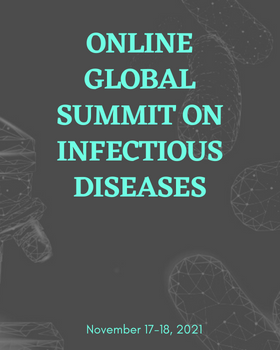


No Of Pages: 1-30
Publisher: CRG Journals Published On: 20 November, 2021
Authors:
Wen Wei1, Zonglei Zhou1, Wenqiang Zhang1, Rongsheng Luan1, Lan Xia2 and Jianlin Wu2
1Sichuan University, China
2Center for Disease Control and Prevention of Sichuan Province, China
Authors:
Ji Yong Lee and Sang Il Kim
H Plus Yangji Hospital, South Korea
Authors:
Nisha Govender and Zeti-Azura Mohamed-Hussein
National University of Malaysia, Malaysia
Authors:
Gilbert Glady
European Bio Immune Gene Medicine Association (EBMA), France
Authors:
Arya Ivan Mahendra, Nyilo Purnami, Erwin Astha Triyono and Lilik Djuari
Universitas Airlangga, Indonesia
Authors:
Raymond Surya, Yudianto Budi Saroyo, Ali Sungkar and Rima Irwinda
Universitas Indonesia/ Dr. Cipto Mangunkusumo Hospital, Indonesia
Authors:
Timbul Partogi H. Simorangkir
Indonesian Defense University, Indonesia
Authors:
Simona Di Pietro1, Marcoaurelio Sciume1, Elisabetta Giudice1, AnnalisaGuercio2. Giuseppa Purpari2, Schiro Giorgia2 and Giuseppe Mira2
1University of Messina, Italy
2Istituto Zooprofilattico Sperimentale della Sicilia, Italy
Authors:
Ashik Babu
University of Liverpool, UK
Authors:
Paola Antonioli
Ferrara University Hospital, Italy
Authors:
Vineeta Mittal
Dr. Ram Manohar Lohia Institute of Medical Sciences, India
Authors:
Yanamadala V Murali Krishna Rao
Lakshmi Vaidyasala, India
Authors:
Laura Holberger
Cambridge Consortium for Rapid COVID-19 Tests, USA
Authors:
Vazquez-Lopez Rosalino1, Espindola-Flores Esteban1, Álvarez-Hernández Diego1, Peña Barreto Adán1, Solano-Gálvez Sandra Georgina2 and JuanAntonio González- Barrios3
1Universidad Anáhuac Mexico Norte, Mexico
2National Autonomous University of Mexico, Mexico
3Genomic Medicine Laboratory, Hospital Regional "Primero de Octubre", Mexico
Authors:
Chávez Guerra Ana Almudena1, Neri Ponce Karla Denisse1, Lores GuerreroMónica1, Álvarez-Hernández Diego1, Vazquez-Lopez Rosalino1,2 and Solano-Gálvez Sandra Georgina2
1Universidad Anáhuac Mexico Norte, Mexico
2National Autonomous University of Mexico, Mexico
Authors:
Ayelet Raz-Pasteur and Mirai Farah Khoury
Rambam Health Care Campus, Israel
Authors:
Noa Eliakim-Raz1, Yaara Leibovici-Weisman1, Salomon M. Stemmer1, AmosStemmer2, Asaf Ness3, Muhammad Awwad3 and Nassem Ghantous3
1Tel Aviv University, Israel
2Sheba Medical Center, Israel
3Rabin Medical Center, Israel
Authors:
Sarah Alsobaie
King Khalid University Hospital, Saudi Arabia
Authors:
Adila Shaukat, Nasir Al Ansari, Walid Al Wali, Edin Karic, Ihab El Madhoun,Hassan Mitwally, Manal Hamed and Feah Alutra-Visan
Hamad Medical Corporation, Qatar
Authors:
Richard H. Kaszynski
Stanford University, USA
Authors:
Mamatha Bhanu L S
University of Mysore, India
Authors:
Ndifontiayong Adamu Ndongho
Dschang University, Cameroon
Authors:
Wanessa Melo
Institute Center for Physical Sciences and Technology, Lithuania
Authors:
Fernanda Monteiro de Castro Fernandes
University of Brasília, Brazil
Authors:
Verónica López Pérez
Hospital Universitario 12 de Octubre, Spain
Authors:
Zvi Laron1, Orit Blumenfeld2, Gabriella Lawrence3 and Lester Shulman4
1Schneider Children’s Medical Center, Israel
2Israel Center for Disease Control, Israel
3Hebrew University, Israel
4Central Virology Laboratory, Israel
Background: Recent studies showed that Rotavirus vaccination may affect the prevalence of type 1diabetes (T1D). Our aim is to determine the prevalence of early childhood (<5 years) T1D before and during the introduction of Rotavirus vaccination in Israel by syndromic surveillance.
Methods: Data on insulin purchases reported by Israel’s four health care organizations (HMOs) was retrieved from the National Program for Quality Indicators in Community Healthcare (QICH).
Results: During the pre- vaccination years (2002-2007) a steady increase of insulin purchases was reported in the young (<5 years). The period percent change (PC) of children aged <5 years old diagnosed with T1D inferred from purchased insulin prescriptions increased by 50.0%, and the annual percent change (APC) increased by 10.0% (p=0.01). During the period of free, universal Rotavirus vaccination(2011-2018), the PC for T1D diagnoses among children aged <5 years decreased by 3.8% with an APC of -2.5% (p=0.14). There was a significant difference (p=0.002) between the increasing trend in insulinuse before vaccination versus the decreasing trend after vaccination.
Conclusion: Rotavirus vaccination correlated with attenuation of the increasing rate in the prevalence of T1D in <5 year-old children in Israel.
Authors:
Valeriy D. Perminov
Bioteckfarm Ltd, Russian Federation
Authors:
Ritu Singhal
National Institute of Tuberculosis and Respiratory Diseases, India
Authors:
Rajni Garg1,2, Salik M. Borbora1, Sandhya Rao1, Harsh Bansia1, PrakrutiSingh1, Rinkee Verma1, Balaji KN1 and Valakunja Nagaraja1
1Indian Institute of Science, India
2CSIR-Institute of Microbial Technology, India